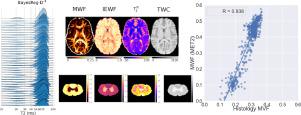NeuroImage ( IF 5.7 ) Pub Date : 2021-09-15 , DOI: 10.1016/j.neuroimage.2021.118582 Erick Jorge Canales-Rodríguez 1 , Marco Pizzolato 2 , Thomas Yu 3 , Gian Franco Piredda 4 , Tom Hilbert 4 , Joaquim Radua 5 , Tobias Kober 4 , Jean-Philippe Thiran 6

|
Multi-echo T2 magnetic resonance images contain information about the distribution of T2 relaxation times of compartmentalized water, from which we can estimate relevant brain tissue properties such as the myelin water fraction (MWF). Regularized non-negative least squares (NNLS) is the tool of choice for estimating non-parametric T2 spectra. However, the estimation is ill-conditioned, sensitive to noise, and highly affected by the employed regularization weight. The purpose of this study is threefold: first, we want to underline that the apparently innocuous use of two alternative parameterizations for solving the inverse problem, which we called the standard and alternative regularization forms, leads to different solutions; second, to assess the performance of both parameterizations; and third, to propose a new Bayesian regularized NNLS method (BayesReg). The performance of BayesReg was compared with that of two conventional approaches (L-curve and Chi-square (X2) fitting) using both regularization forms. We generated a large dataset of synthetic data, acquired in vivo human brain data in healthy participants for conducting a scan-rescan analysis, and correlated the myelin content derived from histology with the MWF estimated from ex vivo data. Results from synthetic data indicate that BayesReg provides accurate MWF estimates, comparable to those from L-curve and X2, and with better overall stability across a wider signal-to-noise range. Notably, we obtained superior results by using the alternative regularization form. The correlations reported in this study are higher than those reported in previous studies employing the same ex vivo and histological data. In human brain data, the estimated maps from L-curve and BayesReg were more reproducible. However, the T2 spectra produced by BayesReg were less affected by over-smoothing than those from L-curve. These findings suggest that BayesReg is a good alternative for estimating T2 distributions and MWF maps.
中文翻译:

重新审视 T2 谱成像逆问题:贝叶斯正则化非负最小二乘法
多回波 T 2磁共振图像包含有关分隔水的 T 2弛豫时间分布的信息,我们可以从中估计相关的脑组织特性,例如髓鞘水分数 (MWF)。正则化非负最小二乘法 (NNLS) 是估计非参数 T 2的首选工具光谱。然而,该估计是病态的,对噪声敏感,并且受所采用的正则化权重的影响很大。这项研究的目的有三个:首先,我们要强调的是,显然使用两种替代参数化来解决反问题,我们称之为标准和替代正则化形式,这会导致不同的解决方案;其次,评估两种参数化的性能;第三,提出一种新的贝叶斯正则化NNLS方法(BayesReg)。BayesReg 的性能与两种传统方法(L 曲线和卡方(X 2) 拟合) 使用两种正则化形式。我们生成了一个合成数据的大型数据集,获取了健康参与者的体内人脑数据以进行扫描-重新扫描分析,并将来自组织学的髓鞘含量与从体外数据估计的 MWF 相关联。合成数据的结果表明,BayesReg 提供了准确的 MWF 估计值,与L曲线和 X 2的估计值相当,并且在更宽的信噪比范围内具有更好的整体稳定性。值得注意的是,我们通过使用替代正则化形式获得了优异的结果。本研究报告的相关性高于先前采用相同离体的研究报告的相关性和组织学数据。在人脑数据中,来自L曲线和 BayesReg 的估计图具有更高的可重复性。然而,BayesReg 产生的 T 2光谱比L曲线产生的 T 2 光谱受过度平滑的影响更小。这些发现表明 BayesReg 是估计 T 2分布和 MWF 图的一个很好的替代方法。



























 京公网安备 11010802027423号
京公网安备 11010802027423号